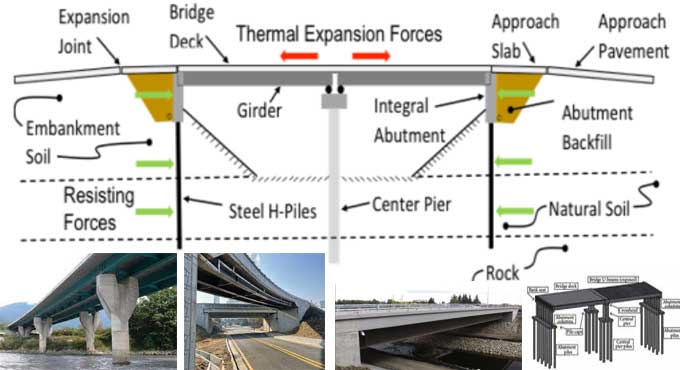NEWS | SOFTWARE | SHEET
An Overview of 2023's Construction for the Integral Bridge
Bridges without joints can be classified as integral bridges. Integral bridges are those without joints between spans and abutments. In light of this, the integral bridge does not necessarily require an expansion joint to accommodate temperature related enlargements.
Incorporating masonry arch bridges is an example of this type of bridge. Consequently, the end walls of the abutment are responsible for deflections or movement caused by subsequent expansion and contraction as well as braking forces.
Importance of Integral Bridge
Compared to conventional bridges, integral bridges require less maintenance. Compared to other jointed bridges, such bridges are more durable. In the long run, the integral bridge can serve as a highway bridge that is economical.
Integral Bridge Types
Bank Pad Abutment
It is similar to the stiff portal type construction to have an integral bridge with a bank pad abutment. Deck beams and end supports are fully integrated in this type of bridge.
Due to the bending moment of the deck beams, these supports can freely slide and rotate during thermal expansion or contraction. The bearing capacity of the soil under such movements, such as sliding and rotation, is greatly impacted.
Therefore, serviceability limit states are set lower than normal static values to compensate. A bank pad abutment forms the end screen wall behind which backfill is filled. In addition, the width of the end screen wall should match the pavement constructed above it.
Semi Integral End Screen Abutment
The deck beams and end screen walls are integrally connected. However, the screen walls at each end of the deck beams offer no support.
The horizontal displacement is resistible by an arrangement of bearings. By building the support separate from the substructure, the soil interaction is eliminated.
Frame Abutment
Similar to portal frame structures, integral bridges have frame abutments. The type of integral bridge in which the deck transmits axial forces, shear forces, and moments directly to the structural support is known as a beam bridge. In the same way as the retaining wall, the backfill is also retained by the abutment frames.
A spread footing and embedded wall footing are preferred for the foundation of this bridge. Beams on the deck react on subsequent contraction or expansion due to the reaction results in a horizontal displacement. As a result, foundation displacement can be prevented by constructing abutments with a certain degree of flexibility.
Flexible Support Abutment
With piles as the foundation, an integral bridge is built with flexible support abutments. The post holes are usually made around the pile and at its depth. It is necessary to create a hole to allow for thermal expansion and contraction of the pile.
Soil foundation interaction must be eliminated by providing sufficient space for horizontal pile movement. For larger pipes, precast concrete rings are used, and for smaller pipes, polythene is used. As into the hole is constructed an inspection duct, the pipes need to be checked periodically for buckling.
Integral Bride Merits
Compared to conventional bridges, integral bridges are cheaper since the maintenance costs are also lower as this type of bridge can be built quickly and easily.
A smooth surface means better riding quality as no expansion joints are present. By replacing an old bridge with an integral bridge, the same foundation can be used and construction costs can be greatly reduced.
It is easy to provide a drainage system behind integral abutments so as to prevent leaks from occurring.
Integral Bridge Demerits
When the temperature fluctuates or changes by more than 51mm, it is not suitable. Under high expansion and contraction stresses, pile foundations can form plastic hinges. Regions with weak subsoil are not suitable for this bridge.
To get more details, go through the following video tutorial.
Lecturer: Midas UK
For steel girder integral bridges, the span is limited to 40m, while for concrete girder integral bridges, up to 50m is allowed.
Integral Bridge Limitations
Whenever there is more than 51 mm of expansion or contraction, it is not suitable. The bridge is not recommended when the subsoil or embankment is weak.


